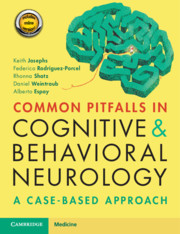Book contents
- Common Pitfalls in Cognitive and Behavioral Neurology
- Common Pitfalls in Cognitive and Behavioral Neurology
- Copyright page
- Dedication
- Contents
- Diseases Discussed in the Book
- Preface
- Acknowledgements
- Abbreviations
- Part 1 Missing the Diagnosis Altogether
- Part 2 Misidentifying the Impaired Cognitive Domain
- Part 3 Missing Important Clues in the History
- Part 4 Failure of Pattern Recognition
- Case 16 Too Many Behavioral Problems for Alzheimer Disease?
- Case 17 Look below the Surface (EEG)
- Case 18 “Too Young to Be Here”
- Case 19 Fluctuating Anxiety
- Case 20 Not Recognizing the Impostor
- Part 5 Difficult-to-Characterize Cognitive/Behavioral Disorders
- Part 6 Clinical Findings That Are Subtle
- Part 7 Misinterpreting Test Results
- Part 8 Attributing Findings to a Known or Suspected Disorder
- Part 9 Missing Radiographic Clues
- Part 10 Management Misadventures
- Index
- Plate Section (PDF Only)
- References
Case 16 - Too Many Behavioral Problems for Alzheimer Disease?
from Part 4 - Failure of Pattern Recognition
Published online by Cambridge University Press: 03 November 2020
- Common Pitfalls in Cognitive and Behavioral Neurology
- Common Pitfalls in Cognitive and Behavioral Neurology
- Copyright page
- Dedication
- Contents
- Diseases Discussed in the Book
- Preface
- Acknowledgements
- Abbreviations
- Part 1 Missing the Diagnosis Altogether
- Part 2 Misidentifying the Impaired Cognitive Domain
- Part 3 Missing Important Clues in the History
- Part 4 Failure of Pattern Recognition
- Case 16 Too Many Behavioral Problems for Alzheimer Disease?
- Case 17 Look below the Surface (EEG)
- Case 18 “Too Young to Be Here”
- Case 19 Fluctuating Anxiety
- Case 20 Not Recognizing the Impostor
- Part 5 Difficult-to-Characterize Cognitive/Behavioral Disorders
- Part 6 Clinical Findings That Are Subtle
- Part 7 Misinterpreting Test Results
- Part 8 Attributing Findings to a Known or Suspected Disorder
- Part 9 Missing Radiographic Clues
- Part 10 Management Misadventures
- Index
- Plate Section (PDF Only)
- References
Summary
A 79-year-old man presented with a 6-year history of worsening gait and balance. He initially complained of heaviness in his legs followed by forgetfulness and a tendency to stumble and fall, initially forward, but he later started falling backward as well. He also manifested word-finding difficulties and trouble with visual navigation. Four years after symptom onset, he developed paranoid ideation and anxiety during a futile trial of levodopa to address the presumptive diagnosis of Parkinson disease. Within months, he became more belligerent, disinhibited, irritable, and uncharacteristically pejorative. He frequently cried and endorsed depression. Word-finding difficulties were compounded by semantic paraphasias (“garage” instead of “cabinet”). He had difficulty locating the food on his plate when eating, particularly if it was located on the left side of the plate. He became wheelchair dependent. His mother had developed dementia in her late seventies. On exam he was alert, but his verbal output was decreased, with hesitations, blocks, semantic and phonemic paraphasias, and palilalia. He exhibited hypomimia, bradykinesia, and rigidity, but no tremor (Video 16.1). A diagnosis of behavioral variant frontotemporal dementia (bvFTD) was made.
- Type
- Chapter
- Information
- Common Pitfalls in Cognitive and Behavioral NeurologyA Case-Based Approach, pp. 49 - 51Publisher: Cambridge University PressPrint publication year: 2020



